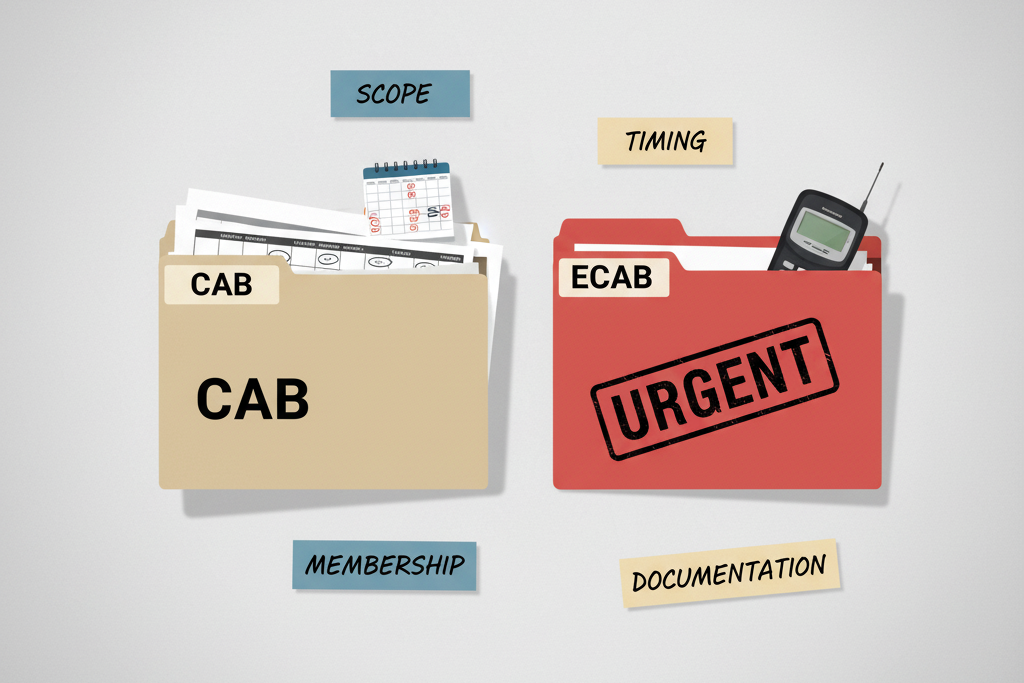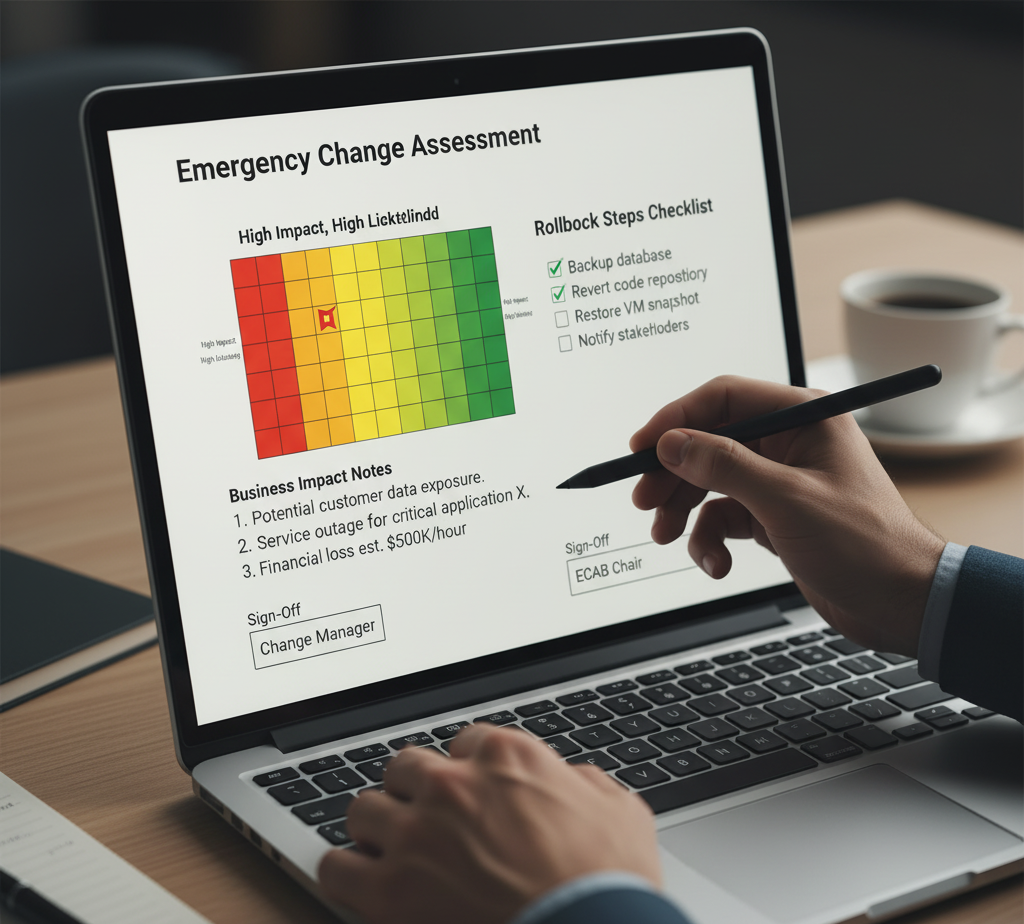Did you know that business downtime can cost anywhere from $12,000 to over $1 million per hour, depending on company size and industry? Imagine a critical IT service unexpectedly failing during peak operations. Every minute lost means mounting financial losses, reputational damage, and growing stakeholder pressure for a swift recovery.
During emergencies like these, organizations need a way to act fast—but without sacrificing risk management or governance. Hasty, uncoordinated changes could worsen the problem or introduce new vulnerabilities. The Emergency Change Advisory Board (ECAB) exists to address this critical need for rapid yet controlled emergency response—a governance mechanism developed under ITIL for stewarding urgent changes with precision.
This article unpacks the essential role of the ECAB, exploring how it functions, who it includes, the business consequences of its actions (or inaction), and how organizations can maximize the value of their ECAB for both IT performance and business continuity.
Understanding Emergency Change Advisory Board (ECAB)
The Emergency Change Advisory Board (ECAB) is a specialized subset of the Change Advisory Board (CAB) within ITIL frameworks, focused on the urgent assessment and approval of emergency changes.
What Qualifies as an Emergency Change?
- Changes needed immediately to resolve or prevent major incidents, security breaches, or service outages
- Critical patches for newly discovered vulnerabilities or system failures with business impact
- Emergency restoration of essential services (e.g., break-fix situations)
How ECAB Differs from CAB
| Category | CAB | ECAB |
| Membership | Broad – includes representatives | Lean, includes only necessary roles |
| Scope | All significant changes | Only emergency/urgent changes |
| Decision Timing | Scheduled, thorough reviews | Immediate, on-demand reviews |
| Documentation | Detailed, full review records | Focused, sometimes post-facto |
ECAB is not a standing committee but is rapidly convened as needed, often with only 3-7 critical decision-makers to streamline approvals and minimize delay.

ECAB Roles and Responsibilities
Core ECAB Functions
- Emergency Change Verification: Confirm whether an urgent request meets the emergency criteria or can be handled as a normal change.
- Risk Assessment: Evaluate technical and business risks, including the potential impact of delay versus implementation.
- Expedited Approval: Make quick, authoritative go/no-go decisions, often within 15 minutes for critical incidents.
- Post-Implementation Review: Ensure changes are documented and evaluated after deployment for continuous improvement.
Who Makes Up the ECAB?
- Change Manager (facilitates the process and keeps records)
- Senior IT Technical Leads (provide impact analysis)
- Business Relationship Owners (assess the urgency for business)
- Security Experts (evaluate compliance and risk)
- On-call/rotational membership to ensure 24/7 availability
ECAB Decision-Making Process
- Emergency request logged
- Rapid convening of ECAB (often virtually)
- Information quickly gathered and assessed
- Approval granted/denied with clear rationale
- Emergency change implemented
- PIR undertaken (within hours or days)

ECAB Key Functions and Operational Framework
Mapping the Emergency Change Journey
- Reception: Emergency requests can arise via IT service desk, automated detection, or business escalation.
- Assessment: The ECAB quickly validates the need for emergency change and assesses available technical/business information.
- Approval: Fast but structured decisions; sometimes approvals are verbal with written documentation post-change.
- Implementation: IT executes the change with predefined rollback plans ready.
- Review: ECAB reconvenes for a post-implementation review, ensuring all learnings and actions are captured.
Also Check: What Are the Benefits of Hiring a Sales Consultant?
Collaboration and Communication
- Use of digital platforms for real-time collaboration
- Stakeholder notification (IT, business, external partners as needed)
- Documentation: Even in emergencies, critical communication and decision records are maintained for auditing purposes

Integration with Standard Change Management
- Emergency changes are recorded and reconciled in the same system as all change requests
- ECAB escalation processes are defined and communicated throughout the organization
- Regular CAB is updated on all emergency changes for transparency and review
Business Impact and Value Proposition
The ECAB’s true power is in its capacity to compress response times without losing sight of risk, compliance, or cost containment.
Downtime Cost by the Numbers
- Average downtime cost: $9,000+ per minute; $500,000+ per hour
- Fortune 1000 annual losses: $1.25–2.5 billion from unplanned downtime
- Mid-market impact: $10,000–$50,000+ per hour
Tangible ECAB Benefits
- Reduced Service Disruption: Emergency situations are resolved faster, lowering financial and reputational harm.
- Controlled Risk: Decisions are made with proper risk oversight, reducing the chance of cascading failures or compliance violations.
- Cost Avoidance: Shorter outages and more predictable recoveries reduce both direct and indirect business costs.
- Audit Readiness: Maintains an auditable trail even for off-hours emergency changes—a common regulator demand.
ECAB-Driven ROI Metrics
- Emergency change rate/success ratios
- Average and cumulative downtime reduction
- Incident recurrence rate reductions
- Enhanced customer satisfaction and stakeholder trust

ECAB Implementation Best Practices
Assembling Your ECAB Dream Team
- Limit membership to those who can make fast, high-quality decisions—generally 3–7 people
- Ensure a mix of technical, business, and risk/compliance expertise
- Set up 24/7 rotation or on-call lists to guarantee availability
Process and Governance
- Predefine emergency criteria—avoid “emergency” overuse
- Deploy templated checklists and assessment questions to speed reviews
- Integrate ECAB processes into existing ITSM/change tools
- Mandate post-implementation reviews for accountability and learning
Leveraging Technology
- Use collaboration platforms for instant ECAB huddles (video, chat, shared docs)
- Automate critical alerts and change logging wherever possible
- Maintain centralized, searchable documentation for all emergency changes
ECAB Success Metrics and KPIs
How does the ECAB prove its worth? By tracking robust operational and business value metrics, including:
- Number of emergency changes reviewed
- Approval/denial rates
- Average response time for ECAB convening and decision
- Emergency change success/failure rates
- Average downtime per incident related to emergency changes
- Mean time to resolution improvements
- Stakeholder satisfaction scores across IT and business units
Participate in regular process reviews and track process improvement metrics, such as PIR completion rates and the effectiveness of implemented lessons learned.
Common ECAB Challenges and Solutions
| Challenge | Solution |
| Overuse of “emergency” classification | Tighten criteria; regular training; trend reviews |
| Insufficient information for decisions | Standardize minimal required input for review |
| Availability of qualified ECAB members | Implement robust on-call system; backups |
| PIR gap—no follow-up on emergency changes | Make PIR mandatory for every emergency change |
Pro tip: Start with “no” as the default for emergency changes—force a strong justification for every emergency request.
Conclusion
The Emergency Change Advisory Board is a cornerstone of robust, agile change management in the digital age. It balances the need for speed with rigorous risk management—even under the most intense pressure.
To maximize ECAB’s value:
- Audit your current emergency change process
- Implement best-practice ECAB governance as described here
- Empower your ECAB with the right tools, training, and authority
- Track results with meaningful KPIs and stakeholder feedback
Need help? Consult with IT change management experts or explore top-tier change management solutions to architect your own effective ECAB structure.
FAQs
1. What qualifies a change as an emergency?
Any change needed immediately to prevent business loss, severe service disruption, or address a new critical security threat.
2. How is ECAB different from CAB?
ECAB is much smaller (3–7 members), focuses only on urgent changes, and convenes on-demand—while CAB is broader and meets on schedule for all significant changes.
3. Who sits on the ECAB?
Typically, senior IT, business, and risk/compliance representatives with authority and expertise for rapid decision-making; sometimes, key external stakeholders as needed.
4. How do you measure ECAB effectiveness?
Track emergency change rates, approval turnaround times, downtime reduction, and the success/failure ratio of ECAB-approved changes.
5. What are common implementation mistakes?
Overusing “emergency” classification, weak documentation, skipping post-change review, and not maintaining 24/7 coverage.
6. How does ECAB work with DevOps?
ECAB can integrate with DevOps pipelines for emergency hotfix approvals, automating much of the documentation and notification flow while still maintaining governance.
7. Do ECAB members need special training?
Yes: training on risk analysis, emergency categorization, decision frameworks, and post-implementation review is highly recommended.

